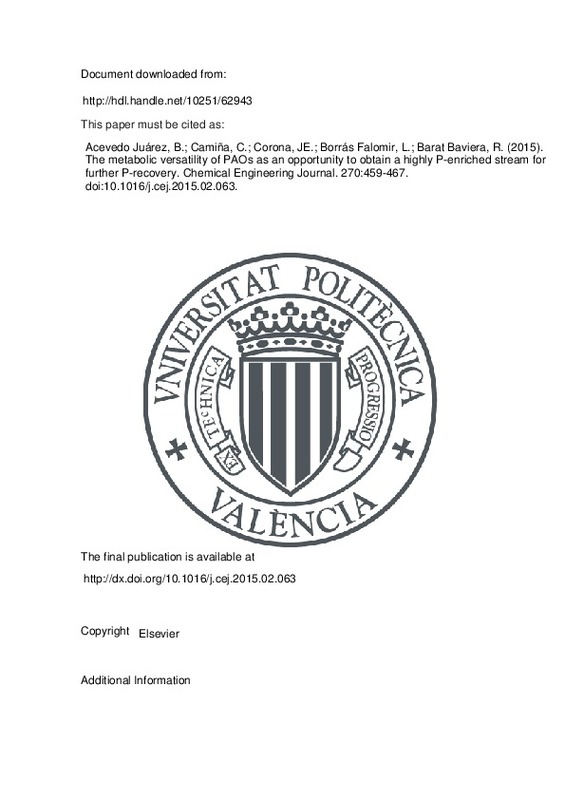JavaScript is disabled for your browser. Some features of this site may not work without it.
Buscar en RiuNet
Listar
Mi cuenta
Estadísticas
Ayuda RiuNet
Admin. UPV
The metabolic versatility of PAOs as an opportunity to obtain a highly P-enriched stream for further P-recovery
Mostrar el registro sencillo del ítem
Ficheros en el ítem
| dc.contributor.author | Acevedo Juárez, Brenda
|
es_ES |
| dc.contributor.author | Camiña, C.
|
es_ES |
| dc.contributor.author | Corona, J. E.
|
es_ES |
| dc.contributor.author | Borrás Falomir, Luis
|
es_ES |
| dc.contributor.author | Barat Baviera, Ramón
|
es_ES |
| dc.date.accessioned | 2016-04-26T11:00:14Z | |
| dc.date.available | 2016-04-26T11:00:14Z | |
| dc.date.issued | 2015-06-15 | |
| dc.identifier.issn | 1385-8947 | |
| dc.identifier.uri | http://hdl.handle.net/10251/62943 | |
| dc.description.abstract | The effects of two sequencing batch reactor operation strategies for phosphorus stream enrichment over the biological phosphorus removal performance have been studied. The objective of both strategies is of performing an extraction cycle in order to obtain a new stream highly enriched with phosphorus. In the 1st strategy the amount of influent volatile fatty acids (VFAs) is the same in each cycle; while in the 2nd strategy the influent VFAs concentration is increased during phosphorus extraction experiments. Despite the strong decrease of the stored poly-P inside the cells in both strategies after the recovery cycles, the ability of the systems to remove phosphorus was not affected. The P-release/HAcuptake ratio (changing from 0.73 to 0.21 mmol P mmol C-1) together with FISH analyses (around 85% of Accumulibacter through the experimental period) confirmed that a shift from PAM to GAM occurred after phosphorus enrichment in the 2nd strategy experiments. These results suggest that energy required for VFA uptake by polyphosphate-accumulating organisms (PAO5) was not only derived from polyphosphates degradation, but also from glycogen degradation. FISH also revealed that Type II Accumulibacter species are responsible of the metabolic shift. The strategy based on increasing influent VFAs concentration during phosphorus extraction experiments showed a higher extraction efficiency (from 46% to 76%), as higher phosphorus concentration within supernatant can be achieved (from 113.9 to 198.7 mg Pl(-1)). Following this strategy, it is possible to concentrate up to 81% of the incoming phosphorus in a single enriched stream. This suggests that, despite the extra addition of carbon source needed (9%), this strategy is more appropriate if phosphorus recovery for reuse purposes is required. (C) 2015 Elsevier BM. All rights reserved. | es_ES |
| dc.description.sponsorship | This research work has been supported by the Generalitat Valenciana (GVPRE/2008/044) and the Polytechnic University of Valencia (PAID-06-08-3227), which are gratefully acknowledged. Special acknowledgements to Consejo Nacional de la Ciencia y la Tecnologia de Mexico (CONACYT) No. 207966. | en_EN |
| dc.language | Inglés | es_ES |
| dc.publisher | Elsevier | es_ES |
| dc.relation.ispartof | Chemical Engineering Journal | es_ES |
| dc.rights | Reserva de todos los derechos | es_ES |
| dc.subject | Phosphorus recovery | es_ES |
| dc.subject | Polyphosphate (poly-P) | es_ES |
| dc.subject | Polyphosphate accumulating metabolism (PAM) | es_ES |
| dc.subject | Glycogen accumulating metabolism (GAM) | es_ES |
| dc.subject | Enhanced biological phosphorus removal (EBPR) | es_ES |
| dc.subject | Sequencing batch reactor (SBR) | es_ES |
| dc.subject.classification | TECNOLOGIA DEL MEDIO AMBIENTE | es_ES |
| dc.title | The metabolic versatility of PAOs as an opportunity to obtain a highly P-enriched stream for further P-recovery | es_ES |
| dc.type | Artículo | es_ES |
| dc.identifier.doi | 10.1016/j.cej.2015.02.063 | |
| dc.relation.projectID | info:eu-repo/grantAgreement/GVA//GVPRE%2F2008%2F044/ | es_ES |
| dc.relation.projectID | info:eu-repo/grantAgreement/UPV//PAID-06-08-3227/ | es_ES |
| dc.rights.accessRights | Abierto | es_ES |
| dc.contributor.affiliation | Universitat Politècnica de València. Instituto Universitario de Ingeniería del Agua y del Medio Ambiente - Institut Universitari d'Enginyeria de l'Aigua i Medi Ambient | es_ES |
| dc.contributor.affiliation | Universitat Politècnica de València. Departamento de Ingeniería Hidráulica y Medio Ambiente - Departament d'Enginyeria Hidràulica i Medi Ambient | es_ES |
| dc.description.bibliographicCitation | Acevedo Juárez, B.; Camiña, C.; Corona, JE.; Borrás Falomir, L.; Barat Baviera, R. (2015). The metabolic versatility of PAOs as an opportunity to obtain a highly P-enriched stream for further P-recovery. Chemical Engineering Journal. 270:459-467. https://doi.org/10.1016/j.cej.2015.02.063 | es_ES |
| dc.description.accrualMethod | S | es_ES |
| dc.relation.publisherversion | http://dx.doi.org/10.1016/j.cej.2015.02.063 | es_ES |
| dc.description.upvformatpinicio | 459 | es_ES |
| dc.description.upvformatpfin | 467 | es_ES |
| dc.type.version | info:eu-repo/semantics/publishedVersion | es_ES |
| dc.description.volume | 270 | es_ES |
| dc.relation.senia | 302806 | es_ES |
| dc.contributor.funder | Generalitat Valenciana | es_ES |
| dc.contributor.funder | Universitat Politècnica de València | es_ES |







![[Cerrado]](/themes/UPV/images/candado.png)

